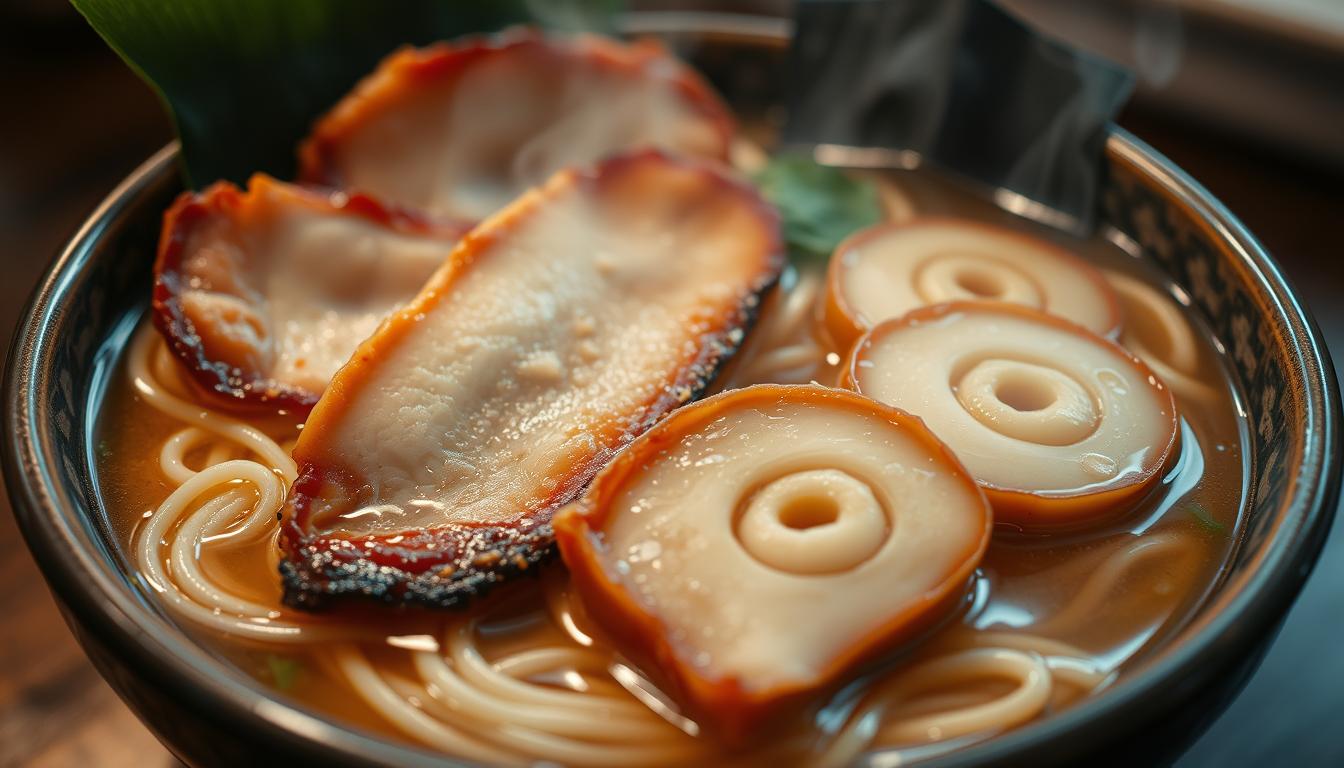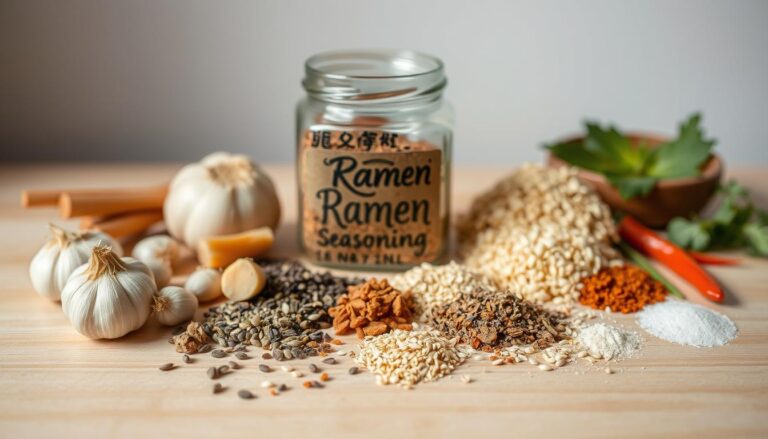Naruto Ramen Recipe – Chashu Pork (braised), Narutomaki (sliced)
Explore Japanese comfort food with our best Naruto ramen recipe. It takes you to Tokyo’s lively streets. This recipe mixes Japanese tradition with flavors and textures that make ramen loved worldwide.
The main ingredient is chashu pork. It’s slow-cooked until it’s incredibly tender. This pork is the heart of a great ramen experience. I’ll show you how to make each part, from the tender chashu to the special narutomaki slices.
Ramen is not just a meal; it’s a form of art. It needs patience, skill, and respect for ingredients. This recipe is perfect for anyone wanting to make a top-notch ramen at home.
Start a tasty adventure that changes how you see Japanese ramen. Follow our guide and tips to make a Naruto ramen that will wow everyone.
Understanding Traditional Japanese Chashu Pork
Exploring the world of naruto ramen reveals the journey of chashu. This beloved protein turns a simple dish into a masterpiece. Chāshū is a Japanese adaptation that connects different cooking traditions.
Chashu’s story starts in China, then travels to Japan. Here, it becomes a key ramen ingredient. Japanese chashu gets its unique taste from special preparation and cooking methods.
Origins of Chashu in Japanese Cuisine
Chashu is Japan’s take on Chinese char siu. It changed from a roasted dish to a slow-cooked delicacy. This shows Japan’s skill in taking foreign dishes and making them their own.
- Chinese origin: Char siu ( )
- Japanese adaptation: Chāshū (チャーシュー)
- Primary meat cut: Pork belly
Difference Between Japanese Chashu and Chinese Char Siu
Though both use pork, their cooking ways are different. Chinese char siu is roasted with spices. Japanese chashu is slow-cooked in soy sauce, sake, and sugar.
Role of Chashu in Ramen Dishes
In naruto ramen, chashu is more than just a topping. It’s a flavor enhancer. The tender, savory meat makes the dish unforgettable.
- Provides rich, savory flavor
- Adds protein and texture
- Enhances overall ramen complexity
Essential Ingredients for Authentic Naruto Ramen Recipe
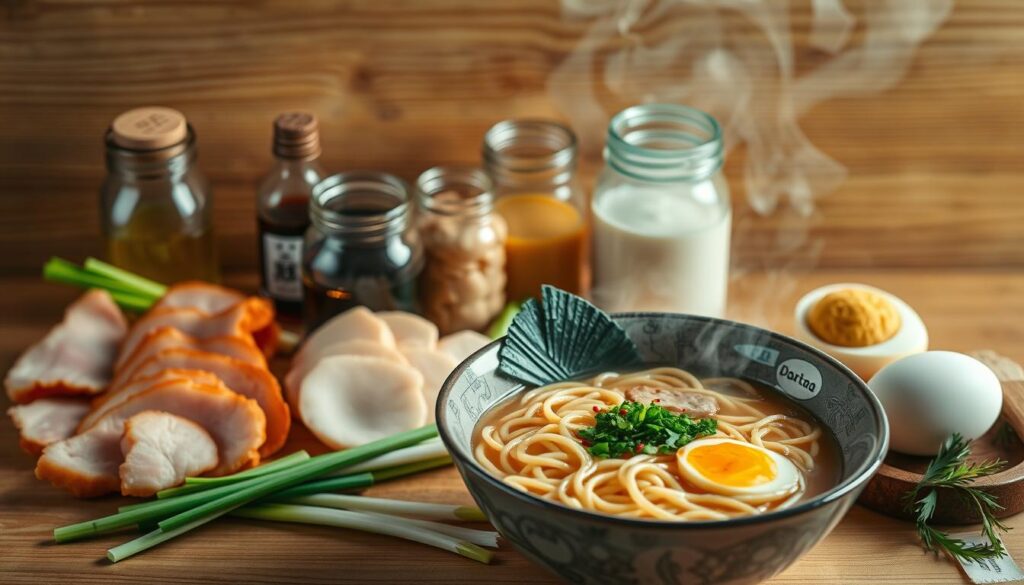
To make an easy Naruto ramen recipe, start by gathering the right ingredients. This simple recipe needs high-quality parts to bring real Japanese flavors to your kitchen.
For the best chashu pork, you need specific ingredients. Each one is key to making the dish special. They help create the rich, complex flavors found in traditional Japanese ramen.
Chashu Pork Ingredients
- Pork Belly: 2-2.5 lbs, premium cut with good fat marbling
- Tokyo Negi: 1 long green onion, green part only
- Fresh Ginger: 4 thin slices
- Sake: 1 cup, high-quality Japanese rice wine
- Soy Sauce: 1 cup, low-sodium preferred
- Water: 2 cups, filtered
- Sugar: 2/3 cup, helps create caramelization
Additional Ramen Components
Beyond the chashu, your simple Naruto ramen recipe will need:
- Rich, flavorful broth
- Thin, springy ramen noodles
- Narutomaki (fish cake)
- Soft-boiled eggs
- Garnishes like green onions
Choosing top-notch ingredients is the key to making your easy Naruto ramen recipe stand out. Each part adds its own flavor and texture. Together, they make a meal that feels like a visit to a Japanese restaurant.
Preparing the Perfect Chashu Pork
Making the perfect chashu pork is key to a great quick naruto ramen recipe. This meat makes a simple ramen dish into a work of art. It will wow anyone who tries it.
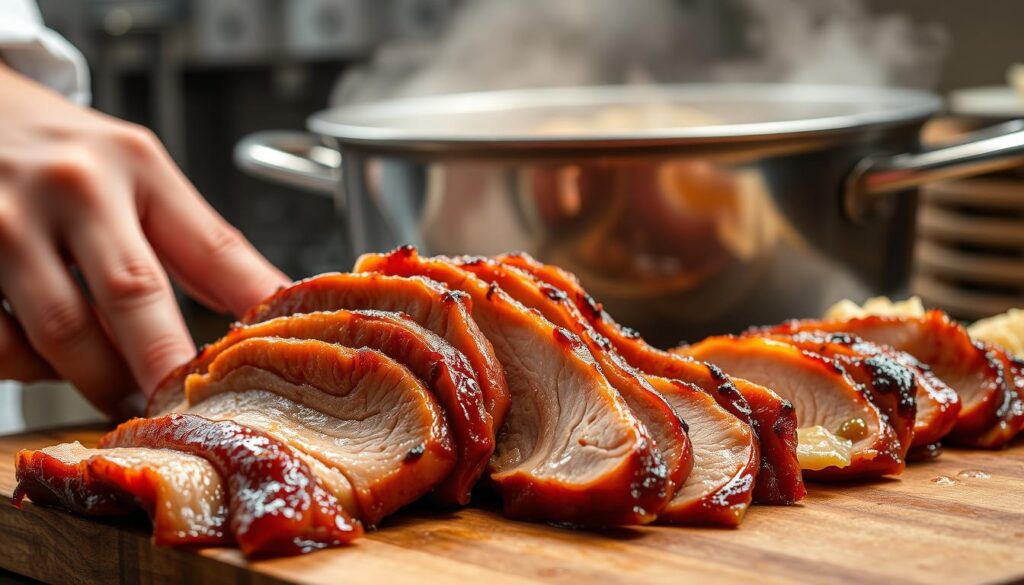
Selecting the Right Cut of Pork Belly
For a top-notch naruto ramen, pick a pork belly with lots of marbling. Aim for a 2-2.5 pound cut with clear layers of meat and fat. It should look like bacon, promising great taste and softness.
Rolling and Tying Techniques
- Position the pork belly with layers facing up
- Roll tightly from one end to create a compact cylinder
- Use butcher’s twine to secure the roll
- Tie at 1/3-inch intervals for consistent shape
Braising Method and Temperature Control
- Sear the rolled pork in a hot skillet for 10-15 minutes
- Brown all sides to lock in flavor
- Prepare braising liquid with:
- Sake
- Soy sauce
- Water
- Sugar
- Simmer at low temperature for 2 hours
- Use a drop lid to keep meat submerged
- Turn every 30 minutes for even cooking
Pro tip: Chill the chashu in its liquid overnight after braising. This step boosts the flavor. Your quick naruto ramen will taste like it came from a restaurant.
Creating the Signature Chashu Braising Sauce
Making the perfect braising sauce is key to a great naruto ramen recipe. It turns simple pork belly into a delicious dish that’s a must-try. Let’s explore how to create complex flavors that make your ramen unforgettable.
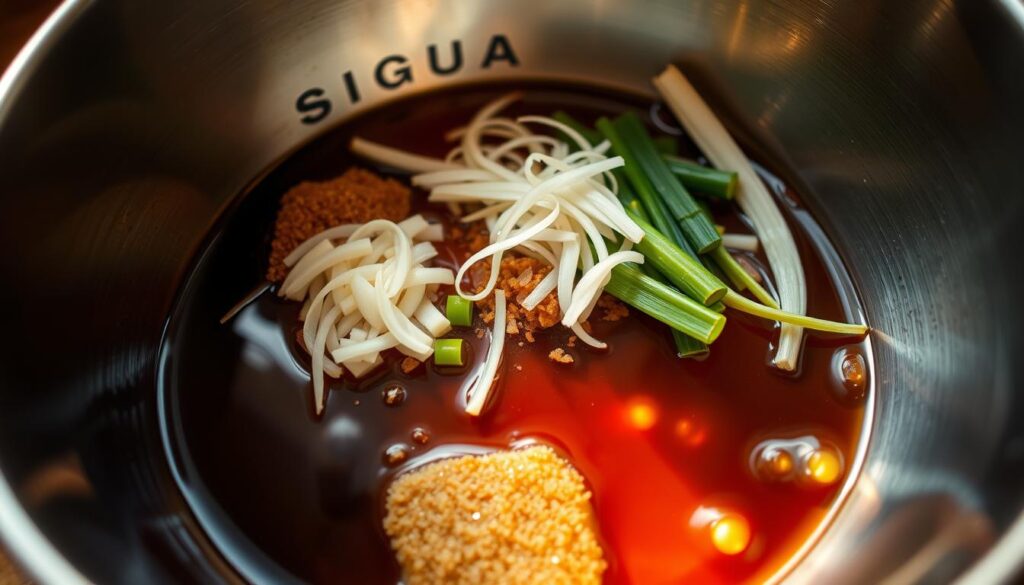
The secret to chashu’s flavor is its rich braising liquid. I’ll share my method for achieving deep, layered tastes in every bite.
- Sake: Provides depth and umami character
- Soy sauce: Delivers saltiness and deep color
- Water: Balances intense flavor profiles
- Sugar: Creates caramelization and subtle sweetness
Choosing the right ingredients is vital for your naruto ramen. Professional chefs understand that each part is essential for amazing flavor.
| Ingredient | Quantity | Purpose |
|---|---|---|
| Sake | 1 cup | Adds complexity and depth |
| Soy Sauce | 1 cup | Provides rich color and saltiness |
| Water | 2 cups | Balances flavor intensity |
| Sugar | 2/3 cup | Creates caramelization |
The secret to the best naruto ramen is patience and precision. Mix these ingredients in a heavy pot. Let them simmer to create a rich, aromatic sauce that turns your pork into a masterpiece.
Pro tip: Add fresh ginger and green onions to your braising liquid. These will give your chashu incredible depth and traditional Japanese flavor.
Step-by-Step Naruto Ramen Recipe
Making an authentic naruto ramen at home is a fun cooking journey. It mixes traditional Japanese methods with tasty flavors. Follow my homemade naruto ramen recipe to make a dish as good as a restaurant’s in your kitchen.
Broth Preparation Essentials
The broth is the heart of any ramen. For a true naruto ramen, focus on rich, deep flavors:
- Select high-quality chicken or pork bones
- Simmer bones for 6-8 hours
- Strain broth multiple times for clarity
- Season with traditional Japanese seasonings
Noodle Selection and Cooking
Choosing the right noodles is key. Go for fresh or top-notch dried ramen noodles:
- Boil water in a large pot
- Cook noodles for 2-3 minutes
- Drain and rinse with cold water
- Separate noodles to prevent sticking
Assembly and Presentation
The last step turns your ingredients into a beautiful ramen dish. In Japanese cooking, how you present matters a lot:
| Ingredient | Placement | Quantity |
|---|---|---|
| Ramen Noodles | Center of Bowl | 1 Cup |
| Chashu Pork | Top Left | 3-4 Slices |
| Narutomaki | Top Right | 2-3 Slices |
| Soft-Boiled Egg | Center | 1 Halved |
| Green Onions | Sprinkled | 2 Tbsp Chopped |
Your authentic naruto ramen is now ready! Each part comes together for a delicious, harmonious meal. It truly captures the spirit of Japanese cooking.
Mastering Narutomaki Preparation
Narutomaki is a classic Japanese fish cake. It adds visual flair and subtle flavor to your ramen. This white fish cake with a pink spiral pattern makes your ramen bowl look like a real Japanese dish.
Making narutomaki needs special techniques and ingredients. It’s made from surimi, a white fish paste. Even though you can buy it pre-made, learning how to make it can make your ramen even better.
Key Components of Narutomaki
- Surimi: White fish paste base
- Food coloring: Pink spiral creation
- Steaming equipment: Essential for cooking
Professional ramen chefs say to use fresh, high-quality fish paste. You need to roll and shape the fish paste carefully. This creates the signature spiral design that makes narutomaki look so good.
Preparation Techniques
- Select premium white fish paste
- Create pink coloring mixture
- Roll and shape fish paste
- Steam until fully cooked
- Slice into thin, uniform pieces
For an easy ramen recipe, you can buy pre-made narutomaki at Asian grocery stores. It’s quicker and adds a real Japanese touch to your homemade ramen.
Advanced Tips for Professional-Style Ramen
To make your simple naruto ramen recipe restaurant-quality, you need a few tricks. I’ll share some insider techniques. These will turn your quick naruto ramen recipe into a culinary masterpiece.
Professional ramen chefs use special methods to make their dishes stand out. Let’s look at some advanced techniques to improve your ramen:
- Sear chashu pork using a culinary butane torch (aburi technique)
- Carefully control noodle texture through precise boiling times
- Layer flavors strategically during assembly
The aburi technique, known as りチャーシュー in Japanese, involves lightly torching the chashu pork surface. This method creates a beautiful caramelized exterior while maintaining the meat’s tender interior. It adds depth and complexity to your ramen’s flavor.
Texture is as important as taste in professional ramen. I recommend investing in high-quality cooking tools like:
- Precision kitchen scale
- Culinary torch
- Instant-read thermometer
Professional chefs know that presentation is key. Arrange your toppings with intention, creating visual appeal that matches the dish’s incredible flavor. Practice your plating techniques to make each bowl look as impressive as it tastes.
Mastering these advanced techniques will transform your home cooking. It will bring authentic Japanese ramen expertise directly to your kitchen.
Storage and Reheating Guidelines
Keeping your naruto ramen recipe delicious means storing and reheating it right. Whether you’ve made chashu pork or a full naruto ramen dish, knowing how to store and reheat is key. It helps keep your dish tasty and fresh.
Proper Storage Techniques
Storing your ramen parts right is vital for their flavor and texture. Here are some important storage tips:
- Separate broth, noodles, and toppings before refrigerating
- Use airtight containers to prevent moisture and flavor loss
- Keep chashu pork in a sealed container to retain its juiciness
Recommended Reheating Methods
Reheating your naruto ramen needs gentle care to keep its taste and texture:
- Reheat broth separately in a pot over medium-low heat
- Warm noodles quickly in hot water for 30 seconds
- Gently warm chashu pork in a skillet or microwave
Maximum Storage Duration
To keep your food safe and tasty, follow these storage times:
- Chashu pork: Refrigerate up to 5-7 days
- Broth: Store in refrigerator for 3-4 days
- Cooked noodles: Best consumed within 1-2 days
- Frozen chashu: Maintain quality for up to 1 month
Pro tip: Freeze your chashu in portions for easy meals later. Label containers with dates to keep track of freshness. Enjoy your homemade naruto ramen at its peak.
Conclusion
Making an authentic naruto ramen recipe is more than just following steps. It’s about finding the right balance of flavors and techniques. This turns simple ingredients into a masterpiece.
Learning to make the perfect chashu pork and choosing the right narutomaki takes practice. Your skills will grow with each batch. The key is to add love and care to every bowl.
Start with these techniques and then try new things. Ramen is all about creativity and personal touch. Your kitchen is a place to explore Japanese cuisine, one bowl at a time.
Whether you’re cooking at home or dreaming of being a chef, this recipe is your chance to dive into a world of flavors. Enjoy the journey, savor each bite, and keep exploring ramen.

